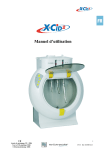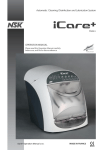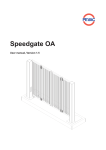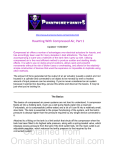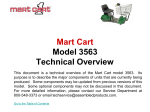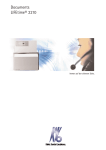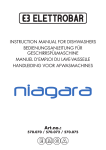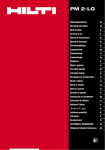Download Manuel d'utilisation
Transcript
����� � MANUEL D’UTILISATION INSTRUCTION MANUAL BEDIENUNGSANLEITUNG 0459 X-Cid® PROCÉDÉ 0459 MANUEL D’UTILISATION � Cet appareil a été conçu et fabriqué conformément à la directive EU 93/42/CE. X-Cid® est un automate pour le nettoyage de l’instrumentation dynamique. CONSIGNES DE SÉCURITÉ ■ X-Cid doit uniquement être utilisé pour la pré-désinfection de l’instrumentation dynamique par du personnel qualifié. ■ L’instrumentation dynamique doit être en bon état. Un instrument endommagé risque de ne pas être correctement pré-désinfecté. ■ Porter des gants médicaux non réutilisables et propres pour toute manipulation de l’instrumentation dynamique et du produit X-Cidol® 2. ■ N’utiliser avec le X-Cid® que les produits recommandés par le fabricant : • Détergent X-Cidol® 2 réf : 50704005 ; • Eau déminéralisée ; • Huile 500I CO2 MICRO-MEGA® réf : 50700029 • L’installation de l’appareil doit être réalisée par un installateur agréé par le constructeur et suivant les instructions du manuel d’installation. ■ Ne pas entreposer l’appareil vers une source de chaleur. ■ Ne pas exposer le X-Cid® aux rayons directs du soleil. ■ Ne pas fumer. ■ Le renouvellement de l’air de la pièce où est installé l’appareil doit être au minimum de 100m3 /h. ■ En cas de non utilisation pendant 4 semaines, faire un cycle à vide avant de mettre en place l’instrumentation dynamique. ■ En cas de contact du détergent avec les yeux, rincer immédiatement et abondamment à l’eau jusqu’à consultation d’un médecin. Consulter la fiche de sécurité du X-Cidol® 2 disponible chez votre distributeur ou chez MICRO-MEGA®. ■ Ne pas démonter ou endommager l’appareil. ■ Ne pas mettre les mains au niveau des charnières lors de l’ouverture du hublot. ■ S’assurer que l’appareil est stable avant toute utilisation. ■ La prise secteur doit avoir une connexion à la terre. ■ Pour séparer l’appareil du réseau électrique, retirer le câble d’alimentation. ■ Débrancher l’appareil et contacter votre distributeur : • Si le fonctionnement de l’appareil vous semble anormal (non respect du temps de cycle, consommation anormale, bruit anormal…). • Si le liquide ne s’évacue plus de la cuve. • En cas de fuite sur la partie arrière de l’appareil. • En cas de détérioration visible de l’appareil. ■ Contacter votre distributeur ou MICRO-MEGA® pour le retraitement en fin de vie de l’appareil conformément à la directive européenne 2002/96/CE ■ Rinçage (2 min 30) Réalisé en rotation avec de l’eau déminéralisée, cette phase permet l’évacuation du X-Cidol® 2 souillé lors de la précédente phase. ® GÉNÉRALITÉS ■ Pré-désinfection (15 min) Toutes les surfaces en contact avec des agents pathogènes sont traitées avec une solution détergente / désinfectante sans aldéhyde, le X-Cidol® 2, respectant les normes en vigueur. Le mouvement des parties rotatives entraînées à basse vitesse garantit l’élimination des substances interférentes. Au cours de cette phase, une grande partie des micro-organismes est éliminée. � ■ Nettoyage (5 min 30) Toujours entraînés en rotation, les instruments sont à nouveau traités par le X-Cidol® 2. Cette phase complémentaire à la phase de pré-désinfection permet d’éliminer tout micro-organisme encore présent. Les instruments sont ainsi parfaitement propres. ■ Rinçage (2 min 30) Réalisé en rotation avec de l’eau déminéralisée, cette phase permet l’évacuation du X-Cidol® 2 souillé lors de la précédente phase. ■ Séchage (3 min) Une fois parfaitement propres et rincés, les instruments sont séchés par de l’air comprimé. ■ Lubrification (2 min 45) Toujours en rotation, les instruments sont alors lubrifiés par une huile spécifique pulvérisée sous pression. Le surplus de lubrifiant est éliminé par de l’air comprimé. DESCRIPTIF ■ Monté sur un châssis en tôle d’acier inox et caréné par une coque en matière synthétique autoextinguible, l’appareil comprend : Un réservoir de produits Un clavier sur lequel sont situées des touches de commandes et des voyants de fonctionnement Introduction ■ Le X-Cid® réalise la pré-désinfection, le nettoyage et la lubrification de vos pièces à main, contre-angles et turbines automatiquement et sans démontage. ■ Les trois instruments traités sont en parfait état technique et de propreté, prêts à être conditionnés et stérilisés. ■ Respectant la circulaire ministérielle N° DGS/5C/DHOS/E2/2001/138 du 14 Mars 2001, le X-Cid® offre aux patients et collaborateurs une assurance contre les infections croisées, augmente la durée de vie de l’instrumentation dynamique et diminue les coûts de maintenance. Le X-Cid® est compatible avec toutes les marques d’instrumentation dynamique. 2 Une cuve en acier inox de traitement fermée par un hublot basculant L’appareil sera équipé en standard de 2 raccords type ISO 3964, pour le raccordement des pièces à main et des contre-angles et de 1 raccord type ISO 9168 (MID) pour le raccordement des turbines Un emplacement pour la mise en place de la bombe de lubrifiant Les connexions électriques, pneumatiques et d’évacuation des fluides sont situées latéralement sur le châssis en tôle 3 1) Cuve de traitement : 3) Bombe de lubrifiant : ■ Fermée par un hublot basculant, elle comprend dans sa partie supérieure trois stations sur lesquelles seront fixés dans l’ordre désiré, chacun par deux vis (1), les embouts de raccordement des instruments qui pourront être soit : • Type ISO 3964, pour le raccordement des pièces à main et des contre-angles (2) ; • Type ISO 9168 (MID) pour le raccordement des turbines (3) ; ces embouts pourront être équipés d’un connecteur rapide pour chaque turbine. poste 1 poste 2 poste 3 ■ La bombe* MM 500 I CO2 sans son bouchon de spray est placée dans son logement situé à droite de l’appareil en emboîtant le tuyau de la bombe dans l’adaptateur bombe. Un ensemble de capteurs détectera la bonne mise en place et la pression de la bombe. Retrait du bouchon de la bombe d’huile. ■ L’implantation des postes de traitement est modifiable suivant l’instrumentation utilisée par le praticien. Mise en place de la bombe d’huile. ■ Chaque poste est équipé de quatre buses de spray afin de réaliser le traitement extérieur (4). 4 * usage exclusif de la bombe d’huile 500I CO2 MICRO-MEGA® (propulsant C02). 1 2 3 2) Réservoir de produits : ■ Situé sur la partie supérieure de l’appareil, le réservoir est constitué de 2 compartiments équipés d’un système de fermeture indépendant et conçus pour recevoir les produits suivants : • X-Cidol® 2, pour les phases de pré-désinfection et nettoyage ; • Eau déminéralisée pour les phases de rinçage. ■ Pour le remplissage, les couvercles respectifs des récipients seront ouverts et les niveaux des récipients seront complétés en utilisant si nécessaire un entonnoir. ■ Ne pas remplir les réservoirs au dessus du niveau maxi afin d’éviter tout débordement. 4) Clavier : ■ Le clavier de commande comprend les éléments suivants : • Une touche de départ cycle ; • Trois touches permettant la sélection des postes utilisés ; • Un ensemble de leds verte, jaune et rouge qui indique : - la mise sous tension (vert) ; - la sélection des postes et que le cycle est en cours de réalisation (jaune) ; - les anomalies (rouge). Led cycle en cours Bouton de démarrage du cycle Bouton station 1 Led sous tension Bouton station 2 Led alarme Bouton station 3 Clavier X-CID® 4 5 MODE D’EMPLOI INSTALLATION / MISE EN SERVICE ■ Le X-Cid doit être installé dans un local bien ventilé. Le renouvellement du volume d’air doit être au minimum de 100m3/h par appareil. Cet apport d’air peut s’effectuer de manière naturelle ou renforcé par des aspirateurs statiques, climatisations ou extracteurs mécaniques. L’installateur guidera le praticien dans son choix. ■ Conçu pour être posé sur une surface horizontale, le X-Cid® peut toutefois être suspendu à un mur, suivant la méthode ci-après : • S’assurer que le mur peut supporter le poids de l’appareil (environ 8 kg). • Fixer dans le mur deux chevilles pour vis de Ø 5 à 5,5 mm espacées de 200 mm. Les vis seront engagées jusqu’à ce que leurs têtes (Ø 10 maxi) soient à 7 mm du mur. ■ Vider les réservoirs et retirer la bombe 500 I CO2 avant tout déplacement de l’appareil. ■ Si le X-Cid® reste plus d’un an sans utilisation, il convient de faire revérifier son fonctionnement par un installateur agréé. ® ÉQUIPEMENT DES POSTES ■ Equiper chaque poste d’un support de pièce suivant le choix désiré, en plaçant : • Soit une douille type ISO 3694 (contre-angles et pièces à main) ; • Soit une douille type ISO 9168 MID (turbines), avec le connecteur rapide adéquat. ■ Connexion pneumatique (1) L’appareil est équipé d’un raccord rapide pour être connecté à un tuyau souple de Ø 4x6. Pour la connexion, vérifier que la coupe du tuyau soit propre afin d’éviter toute fuite. ■ Connexion électrique (2) Raccorder le X-Cid® au réseau électrique à l’aide du cordon fourni en respectant les indications de la fiche signalétique. La prise secteur doit être facilement accessible et doit avoir une connexion à la terre. ■ Evacuation des fluides (3) Pour l’évacuation des effluents, le tuyau (Ø 25 extérieur) est directement relié à l’évacuation des eaux usées. L’ensemble des composants est biodégradable. S’assurer que l’étanchéité entre la canalisation et le tuyau soit correcte et que celui-ci ait une inclinaison suffisante. 1) S’assurer que les niveaux de liquides soient supérieurs aux niveaux minimaux. 2) Mettre l’appareil sous tension en appuyant sur le bouton 0/1, la led verte « mise sous tension » est allumée. 3) Ouvrir la porte basculante de la cuve de traitement et monter les pièces à traiter : • Pour mettre en place les contre-angles et les pièces à main, les emboîter à fond (on entend l’encliquetage). Pour les dégager, appuyer sur le bouton et tirer ; • Pour mettre en place les turbines, les emboîter sur le connecteur. 4) Fermer la porte. 5) Appuyer sur les touches 1-2-3 pour activer les postes de traitement correspondants, les leds jaunes des postes sélectionnés clignotent. • Attention ! l’instrumentation dynamique devra subir un nouveau traitement en cas d’interruption volontaire ou involontaire du cycle afin de garantir l’efficacité du traitement ; • N’appuyer que sur les postes en fonctionnement sinon du produit de nettoyage sera inutilement utilisé ; • Contrôler que les stations utilisées soient bien sélectionnées sur le clavier. 6) Appuyer sur la touche « départ cycle » : • Durant le cycle les leds jaune « cycle » et « postes utilisés » sont allumées ; • En fin de cycle la led « cycle » est éteinte et les leds des postes utilisés clignotent ; • En cas d’arrêt de cycle volontaire les leds des stations sont éteintes (ce qui indique une remise à zéro). L’opérateur doit à nouveau sélectionner les stations pour autoriser le départ du cycle. Mode sans lubrification Avec votre X-Cid® vous avez la possibilité d’avoir un mode sans lubrification en combinant lors de la mise sous tension l’appui sur la touche « 1 » du clavier avec l’interrupteur de mise sous tension. Clavier X-Cid® en mode sans lubrification 2 1 3 L’information du fonctionnement sans lubrification est indiquée par l’allumage de la led rouge pendant 5 secondes lors de la mise sous tension. 6 7 ENTRETIEN ET CONSEILS Le X-Cid a été conçu pour réaliser le traitement et la lubrification de l’instrumentation dynamique après chaque patient. Les quelques conseils qui suivent vous aideront à tirer le meilleur parti de l’appareil et des instruments : ® ■ Pour les instruments qui ne sont pas neufs, avant leur premier passage au X-Cid®, nous vous conseillons de réaliser un nettoyage interne complet pour supprimer les éventuelles accumulations de salissures ; ■ Traitez vos instruments sans attendre que les résidus de salive, sang, etc n’aient le temps de coaguler ou sécher ; ■ Les instruments une fois traités doivent être emballés (conditionnés) pour être stérilisés. ■ Lors d’un acte long (> à 15 min) avec instruments rapides (contre-angle bague rouge ou turbine), nous vous conseillons de lubrifier manuellement vos instruments en cours de traitement, car les flux d’air tendent à éliminer le lubrifiant. Entretien journalier ■ Avant la première utilisation quotidienne du X-Cid®, vérifier le niveau des liquides. En cas d’oubli de cette opération, dès que les niveaux de produits seront insuffisants, le cycle s’arrêtera automatiquement et une alarme se déclenchera. ■ Nettoyer l’extérieur de l’appareil avec une serviette imprégnée de désinfectant. Ne jamais utiliser de produit abrasif. Alimentation pneumatique : • Pression d’alimentation : maxi=8 bars / mini=5 bars • Consommation moyenne : 2 l/minute • Qualité de l’air : filtration à 1 micron et teneur résiduelle eau/huile 0,5 ppm à 25 °C • Raccordement : par raccord rapide pour tuyau 4x6 Evacuation : Par tuyau (Ø 25 mm ext.) raccordé à l’appareil, directement dans la canalisation des eaux usées sans siphon. Liquides de traitement : • Pré-désinfection et nettoyage : X-Cidol® 2 Réf : 50704005 • Rinçage : eau déminéralisée • Lubrification : Bombe de spray MICRO-MEGA® 500 I CO2 Réf: 50700029 INSTRUMENTS TRAITES ■ Toutes les pièces à main, contre-angles et turbines permettent au X-Cidol® 2 de parcourir l’ensemble des composants et des structures de l’arrière vers l’orifice avant de la tête. Entretien mensuel ■ Sélectionner les trois stations, faire fonctionner l’appareil sans instrument et vérifier que le liquide coule bien à chaque poste. Entretien annuel ■ Un contrôle volumétrique de l’appareil doit être réalisé tous les ans par un technicien agréé par le fabricant. Fusibles ■ Les fusibles sont situés vers l’interrupteur marche/arrêt. Ils doivent être remplacés par des fusibles de même type (voir paragraphe caractéristiques). CARACTERISTIQUES Définition : Le X-Cid® est un automate de nettoyage préparateur à la stérilisation. • Température ambiante pour un fonctionnement optimal : 10°C à 40°C (50°F à 104°F). • Hygrométrie ambiante pour un fonctionnement optimal : 10% à 80% HR. • Pression atmosphérique pour un fonctionnement optimal : 500 hPa à 1060 hPa. Dimensions : H=47cm /L=40cm /P=23cm Poids : 8 kg Caractéristiques électriques : Réf : 51100003 = 230V Réf : 51100004 = 230V Réf : 51100005 = 230V Réf : 51100007 = 110V Réf : 51100009 = 100V • Classe électrique : I • Puissance : 38 Watts Protection : +/- 10% 50-60Hz EU +/- 10% 50-60Hz CH +/- 10% 50-60Hz UK +/- 10% 50-60Hz US +/- 10% 50-60Hz Japan • 2 fusibles rapides 0,2 Amp (5x20 mm) pour les X-Cid® en 230 V • 2 fusibles rapides 0,5 Amp (5x20 mm) pour les X-Cid® en 100 et 110 V 8 ■ En cas de doute, contactez votre distributeur. ■ Il est impératif de réviser vos anciens instruments avant l’utilisation du X-Cid®. ■ Le Fabricant se réserve le droit de modification de construction et des caractéristiques de l’appareil sans préavis. GARANTIE ■ Pour toute intervention autre que celles décrites ci-dessus, contacter le service technique de votre revendeur. ■ Le X-Cid® est garanti pour une période de 24 mois suivant la date d’installation contre tout défaut de fabrication, à l’exception des dommages causés par des défauts de manipulation ou d’entretien, par l’utilisation de produits (détergent/désinfectant, eau déminéralisée et huile) non appropriés ou d’autres non recommandés par le fabricant et le non respect du mode d’emploi de l’appareil. 9 AFFICHAGE AFFICHAGE DES ANOMALIES DE FONCTIONNEMENT Voir carte protocole Réf. 60300550 Voyants Voyant éteint Voyant mise sous tension Voyant allumé fixe Voyant défaut fixe Voyant clignotant Voyant défaut clignotant AFFICHAGE EN FONCTIONNEMENT NORMAL Voir carte protocole Réf. 60300550 • Cycle en cours avec la station 1 sélectionnée • Cycle en cours avec les 3 stations sélectionnées 10 • Cycle en cours avec les stations 1 et 2 sélectionnées • 3 stations sélectionnées avant départ cycle • Fin de cycle avec les 3 stations sélectionnées • Hublot mal fermé et station 1 sélectionnée • Hublot mal fermé et stations 1 et 2 sélectionnées • Hublot mal fermé et les 3 stations sélectionnées • Absence de liquide (H2O ou X-Cidol® 2) • Absence d’air • Défaut moteur Après une anomalie de fonctionnement et en cas d’ouverture du hublot, le port d’un masque chirurgical et de gants est recommandé. • Bombe d’huile vide ou mal positionnée 11 X-Cid® PROCEDURE 0459 INSTRUCTION MANUAL � This device has been designed and manufactured in accordance with EU Directive 93/42/CE. X-Cid® is an automated device for cleaning handpieces, contra-angles, and turbines. ■ Rinsing (2 min 30 s) The rotating instruments are rinsed with demineralised water to evacuate the X-Cidol® 2 used in the previous phase. SAFETY INSTRUCTIONS ■ X-Cid® must only be used by qualified personnel to pre-disinfect handpieces, contra-angles, and turbines. ■ The instrument must be in good working order. It may not be possible to properly clean a damaged instrument. ■ Always wear clean, disposable medical gloves when handling handpieces, contra-angles, turbines and X-Cidol®. ■ Only use manufacturer recommended products with the X-Cid®: • X-Cidol® 2 detergent; Ref.: 50704005 • Demineralised water • 500I CO2 MICRO-MEGA® oil; Ref.: 50700029 • The device must be installed by a manufacturer-certified technician following the instructions in the installation manual. ■ Do not store the device near a heat source. ■ Do not expose the X-Cid® to direct sunlight. ■ Do not smoke in close proximity to the device. ■ The air exchange rate in the room where the device is installed must be at least 100m3 /h. ■ In the event the device is not used for four (4) weeks, complete an empty cycle before installing instruments in the treatment tank. ■ If detergent comes in contact with the eyes, rinse immediately and thoroughly with water and consult a physician. Consult the X-Cidol® 2 safety data sheet available from your distributor or MICRO-MEGA®. ■ Do not disassemble or damage the device. ■ No not place your hands on the hinges when opening the window. ■ Make sure the device is solidly seated before use. ■ The wall socket must be grounded. ■ To unplug the device, remove the power cable. ■ Unplug the device and contact your distributor: • If the device seems to be operating abnormally (time cycles not respected, abnormal liquid consumption, abnormal noise, etc.) • If the liquid is no longer evacuated from the reservoir. • If there is a leak at the back of the device. • If there is visible damage to the device. ■ Contact your distributor or MICRO-MEGA® in order to dispose of the device at the end of its service life in accordance with EU Directive 2002/96/CE . ■ Pre-disinfection (15 min) All surfaces in contact with pathogens are treated with X-Cidol® 2, an aldehyde-free detergent/ disinfectant solution that complies with current standards. The internal parts of instruments are rotated at low speed to eliminate interfering substances as well as most microorganisms. � ■ Cleaning (5 min 30 s) The instruments are again rotated in X-Cidol® 2. This phase complements the pre-disinfection phase and eliminates all remaining microorganisms, leaving the instruments totally clean. ■ Rinsing (2 min 30 s) The rotating instruments are rinsed with demineralised water to evacuate the X-Cidol® 2 used in the previous phase. ■ Drying (3 min) Once clean and rinsed, the instruments are dried using compressed air. ■ Lubricating (2 min 45 s) The rotating instruments are then lubricated using special oil applied using a mounted spray can. The excess lubricant is removed using compressed air. DESCRIPTION ■ The device is mounted on a stainless steel frame with a self-extinguishing synthetic hull and includes: A product reservoir A keyboard with the control keypads and indicators Two (2) standard ISO 3964 couplings for handpieces and contra-angles and one (1) ISO 9168 (MID) coupling for a turbine GENERAL A dock for the oil spray can Introduction ■ The X-Cid® automatically pre-disinfects, cleans and lubricates handpieces, contra-angles, and turbines with no disassembly required. ■ Treated instruments are clean and in perfect working order, ready to be packaged and sterilised. ■ Since the X-Cid® complies with Administrative Circular N° DGS/5C/DHOS/E2/2001/138 of 14 March 2001, patients and health personnel can be assured that there is no risk of cross-infection. In addition, the X-Cid® increases the service life of instruments, reduces maintenance costs, and is compatible with all brands of handpieces, contra-angles, and turbines. 12 A stainless steel treatment tank with a window Electrical, compressed air, and fluid evacuation outlets on the side of the steel frame 13 1) Treatment Tank: 3) Oil spray can: ■ The treatment tank, which has a window, has three stations that can accommodate instrument couplings in any order. Each coupling is held in place by two screws (1). Two types of couplings can be used: • Type ISO 3964 for handpieces and contra-angles (2). • Type ISO 9168 (MID) for turbines (3); these couplings can be equiped with quickconnectors for each turbine. ■ The order of the coupling can be changed to accommodate the types of instruments being used. ■ Each station is equipped with four spray nozzles to treat the external surfaces of the instruments (4). station 1 station 2 station 3 ■ The MM 500 I CO2 oil spray can*, with its cap removed, is placed in its dock on the right hand side of the device. A set of sensors monitors the correct positioning and pressure of the spray can. Remove cap from spray can. Place oil spray can in its dock. 4 * Use only MICRO-MEGA® 500I CO2 oil spray cans (C02 propellant) 1 2 2) Product reservoir: ■ The reservoir is located in the top of the device and is composed of two compartments with independent hinged lids. It has been designed for use with the following products: • X-Cidol® 2 detergent / disinfect for the pre-disinfection and cleaning phases. • Demineralised water for the rinsing phases. ■ To fill, the covers of the two compartments are opened and the appropriate quantity of product is added up to the fill line using a funnel, if necessary. ■ Do not exceed the fill line to avoid overflows. 4) Keypad: 3 ■ The control keypad includes the following components: • A cycle start button • Three buttons to select the desired stations • Green, yellow and red LED indicators: - Power on (green) - Stations selected and cycle underway (yellow) - Malfunction (red). LED cycle underway Cycle start button Station 1 button LED power on Station 2 button LED alarm Station 3 button X-Cid® Keypad 14 15 INSTALLATION / USE DIRECTIONS FOR USE ■ The X-Cid® must be installed in a well ventilated room. The air exchange rate must be at least 100m3 /h per device. The air exchange may be passive or may be assisted by static extractors, air conditioners, or mechanical extractors. The technician will provide the end user with advice in this regard. ■ The X-Cid® is designed to be installed on a horizontal surface, but may be wall mounted using the following method: • Make sure the wall can support the weight of the device (approx. 8 kg). • Place two anchors (rawl plugs) for Ø 5 to 5.5 mm screws in the wall 200 mm apart. The screws must be screwed into the anchors so that their heads (Ø 10 maxi) protrude 7 mm from the wall. ■ Empty the reservoirs and remove the 500 I CO2 spray can before moving the device. ■ If the X-Cid® is not used for a year or more, it should be inspected by a certified installer. EQUIPMENT ■ Equip each station with the following parts, depending on the instruments to be treated: • ISO 3694 coupling (contra-angles and handpieces). • ISO 9168 MID coupling (turbines) with suitable quick-connector. ■ Compressed air connection (1) The device is equipped with a quick-connector for Ø 4x6 flexible tubing. Check that the tubing has a clean cut to ensure an airtight connection. ■ Electrical connection (2) Plug in the X-Cid® using the power cord provided. Comply with the safety data sheet. The wall socket must be easily accessible and must be grounded. ■ Fluid evacuation (3) The tubing for evacuating waste fluids (Ø 25 ext.) is directly connected to the waste outlet. All components are biodegradable. Make sure that the connection is watertight and that the tubing has a sufficient downward slope. 1) Make sure that the fluids exceed the minimum required levels. 2) Turn on the device by pressing the 0/1 button. The green “power on” LED will light up. 3) Open the hinged door of the treatment tank and install the instruments to be treated: • Insert contra-angles and handpieces completely. You will hear a click. To remove them, press the button and pull. • Place turbines on the quick-connect coupling. 4) Close the door. 5) Press buttons 1, 2, and/or 3 to activate the corresponding treatment stations. The yellow LEDs of the selected stations will blink. • Caution ! Instruments should undergo another complete treatment cycle in the event the cycle is voluntarily or involuntarily interrupted in order to ensure an effective treatment. • Only select those stations with an attached instrument. Otherwise, cleaning product will be wasted. • Make sure the stations to be used are correctly selected on the keypad. 6. Press the “start cycle” button. • During the cycle, the yellow “cycle” and “stations in use” LEDs will light up. • At the end of a cycle, the “cycle” LED will turn off and the “stations in use” LEDs will blink. • If the user voluntarily stops the cycle, the “stations in use” LEDs will turn off (which indicates a reset). The user must reselect the stations before starting a new cycle. Non-lubricating mode You may also operate the X-Cid® in non-lubricating mode by pressing the “1” button at the same time as the “power on” button. X-Cid® keypad in non-lubricating mode. 2 1 3 If the non-lubricating mode is selected, the red LED will light up for 5 seconds when the power is turned on. 16 17 MAINTENANCE AND TIPS The X-Cid® has been designed to clean and lubricate handpieces, contra-angles, and turbines after each patient. The following tips will help you make the best use of the device and your instruments: ■ If your instruments are not new, we recommend a complete internal cleaning to remove accumulated debris prior to a treatment with the X-Cid®. ■ Treat your instruments immediately after use so that saliva and blood do not have time to coagulate or dry. ■ Once treated, instruments must be packaged for sterilization. ■ During long dental procedures (> 15 min) with fast rotating instruments (contra-angles with red rings or turbines), we recommend that you manually lubricate your instruments during the procedure because the air flow tends to eliminate the lubricant. Daily maintenance ■ Before the first daily use of the X-Cid®, verify the fluid levels. In the event you forget this step, the cycle will stop automatically and an alarm will be triggered when fluid levels fall too low. ■ Clean the outside of the device with a soft towel dipped in disinfectant. Never use abrasives. Compressed air feed: • Feed pressure: max.=8 bars / min.=5 bars • Average flow: 2 l/minute • Air quality: 1 micron filter; residual water/oil=0.5 ppm at 25°C • Connection: quick-connect for 4x6 tubing Evacuation: Tube (Ø 25 mm ext.) connected directly to the waste fluid outlet without siphon. Treatment fluids: • Pre-disinfection and cleaning: X-Cidol® 2 detergent; Ref.: 50704005 • Rinsing: Demineralised water • Lubricating: MICRO-MEGA® 500 I CO2 oil; Ref.: 50700029 INSTRUMENTS TREATED ■ The X-Cidol® 2 detergent solution penetrates the components and structures of all commercially available handpieces, contra-angles and turbines, from the bottom to the orifice at the head. Monthly maintenance ■ Select all three stations, operate the device without instrument, and verify that there is a good flow of fluid at each station. Annual maintenance ■ The volumetric flow of the device must be tested one a year by a manufacturer-certified technician. Fuses ■ The fuses are located near the ON/OFF switch. They must be replaced by fuses of the same type (see Characteristics). CHARACTERISTICS Definition: The X-Cid® is an automated pre-sterilization cleaning device. • Ambient temperature for optimal operation: 10°C to 40°C (50°F to 104°F) • Ambient humidity for optimal operation: 10% to 80% RH • Atmospheric pressure for optimal operation: 500 hPa (millibars) to 1,060 hPa (millibars). Dimensions: H=47cm /L=40cm /W=23cm Weight: 8 kg Electrical: Ref.: 51100003 = 230V Ref.: 51100004 = 230V Ref.: 51100005 = 230V Ref.: 51100007 = 110V Ref.: 51100009 = 100V Electric class: I Power: 38 Watts Protection : +/- 10% 50-60 Hz EU +/- 10% 50-60 Hz CH +/- 10% 50-60 Hz UK +/- 10% 50-60 Hz USA +/- 10% 50-60 Hz Japan • Two 0.2 Amp fast blow fuses (5x20 mm) for the 230 V X-Cid® • Two 0.5 Amp fast blow fuses (5x20 mm) for the 100 and 110 V X-Cid® 18 ■ In case of any doubts, contact your distributor. ■ It is essential to carefully examine your old instruments before treating them with the X-Cid®. ■ The manufacturer reserves the right to modify the construction and characteristics of the device without prior notice. WARRANTY ■ For any manipulations other than those described above, please contact the service department of your distributor. ■ The X-Cid® is guaranteed for 24 months following the installation date against any manufacturing defects, with the exception of damage caused by improper handling or maintenance, the use of unsuitable products or products that are not recommended by the manufacturer (detergent/disinfectant, demineralised water and oil), or non-compliance with the operating instructions for the device. 19 DISPLAYS MALFUNCTION DISPLAYS See X-Cid® protocol sheets; Ref. 60300550 Indicators Off Power on Steady Malfunction Flashing Malfunction flashing NORMAL OPERATION DISPLAYS See X-Cid® protocol sheets; Ref. 60300550 20 • Cycle underway with station 1 selected • Cycle underway with stations 1 and 2 selected • Cycle underway with 3 stations selected • 3 stations selected before cycle start • End of cycle with 3 stations selected • Window not properly closed and station 1 selected • Window not properly closed and stations 1 and 2 selected • Window not properly closed and all stations selected • Liquid not present (H2O or X-Cidol® 2) • Air not present • Motor malfunction • Oil spray can empty or improperly positioned We recommend that the operator wear a surgical mask and gloves in the event the device malfunctions or the window opens. 21 X-Cid® ABLAUF 0459 BEDIENUNGSANLEITUNG � Dieses Gerät ist gemäß Medizinprodukterichtlinie 93/42/EWG konstruiert und hergestellt. X-Cid® ist ein Gerät zur automatischen Reinigung von Hand-, Winkelstücken und Turbinen. ■ Spülung (2 min 30 s) Die rotierenden Instrumente werden mit demineralisiertem Wasser gespült, um das in der vorhergehenden Phase verwendete X-Cidol® 2 zu entfernen. SICHERHEITSHINWEISE ■ X-Cid® darf nur von qualifiziertem Personal angewendet werden, um Hand-, Winkelstücke und Turbinen aufzubereiten. ■ Das Instrument muss in funktionsfähigem Zustand sein. Defekte Instrumente können möglicherweise nicht ordnungsgemäß aufbereitet werden. ■ Bei der Arbeit mit Hand-, Winkelstücken, Turbinen und X-Cidol® 2 stets saubere medizinische Einmalhandschuhe tragen. ■ Im X-Cid® dürfen nur vom Hersteller empfohlene Produkte eingesetzt werden: • X-Cidol® 2 Reinigungslösung; Art.-Nr.: 50704005 • Demineralisiertes Wasser • 500I CO2 MICRO-MEGA® Öl; Art.-Nr.: 50700029 • Das Gerät muss entsprechend der Anweisungen in der Installationsanleitung von einem vom Hersteller zugelassenen Techniker angeschlossen werden. ■ Das Gerät nicht neben einer Wärmequelle aufstellen. ■ Das Gerät nicht direktem Sonnenlicht aussetzen. ■ In der Nähe des Gerätes nicht rauchen. ■ Die Luftaustauschrate in dem Raum, in dem das Gerät aufgestellt ist, muss mindestens 100m3 /h betragen. ■ Falls das Gerät vier Wochen lang nicht verwendet wurde, muss zunächst ein Leerlaufzyklus durchgeführt werden, bevor Instrumente in die Reinigungskammer eingebracht werden. ■ Im Falle eines Augenkontaktes mit der Reinigungslösung Auge sofort und gründlich mit Wasser spülen und einen Arzt aufsuchen. Beachten Sie das X-Cidol® 2 Sicherheitsdatenblatt. Es ist bei Ihrem Dental-Händler oder direkt bei MICRO-MEGA® erhältlich. ■ Gerät nicht zerlegen oder beschädigen. ■ Die Hände beim Öffnen der Gerätetür nicht auf die Scharniere legen. ■ Zum Gebrauch des Gerätes standfeste Aufstellung sicherstellen. ■ Der Stromanschluss muss geerdet sein. ■ Um das Gerät vom Stromnetz zu trennen, ziehen Sie den Stecker heraus. ■ Ziehen Sie in folgenden Fällen den Stecker heraus und nehmen Sie mit Ihrem Händler Verbindung auf: • Wenn das Gerät eine Störung aufweist (die Zeit des Zyklus wird nicht respektiert, anormaler Verbrauch, anormale Geräusche) • Wenn die Flüssigkeit nicht mehr aus dem Behälter abfließt • Wenn der hintere Teil des Gerätes leckt • Wenn das Gerät eine sichtbare Beschädigung aufweist ■ Wenden Sie sich bitte an Ihren Händler oder an MICRO-MEGA® um das Gerät am Ende seiner Nutzungsdauer gemäß EU-Richtlinie 2002/96/CE .zu entsorgen. ALLGEMEINES Einleitung ■ Das X-Cid Gerät „vor-desinfiziert“*, reinigt und ölt automatisch Hand-, Winkelstücke und Turbinen, ohne dass sie zerlegt werden müssen. Die damit aufbereiteten Instrumente sind sauber und voll funktionsfähig, fertig vorbereitet für Verpackung und Sterilisation. ■ X-Cid® entspricht den Anforderungen des amtlichen (französischen) Rundschreibens DGS/5C/DHOS/ E2/2001/138 vom 14 März 2001. Patienten und Gesundheitspersonal können deshalb sicher sein, dass kein Risiko einer Kreuzinfektion besteht. Außerdem verlängert X-Cid® die Lebensdauer von Instrumenten, vermindert Reparaturkosten und ist für alle Fabrikate von Hand-, Winkelstücken und Turbinen geeignet. * nach geltenden französischen Richtlinien 22 ■ „Vor-Desinfektion“* (15 min) Sämtliche kontaminierten Oberflächen werden mit X-Cidol® 2 behandelt, einer aldehydfreien Reinigungs-/Desinfektionslösung, die geltenden Standards entspricht. Die Innenteile werden langsam gedreht, um störende Fremdsubstanzen und die meisten Mikroorganismen zu entfernen. � ■ Reinigung (5 min 30 s) Die Instrumente rotieren erneut in X-Cidol® 2. Diese Phase ergänzt die „Vor-Desinfektions-Phase“* und beseitigt alle verbliebenen Mikroorganismen, die Instrumente werden vollkommen sauber. ■ Spülung (2 min 30 s) Die rotierenden Instrumente werden mit demineralisiertem Wasser gespült, um das in der vorhergehenden Phase verwendete X-Cidol® 2 zu entfernen ■ Trocknung (3 min) Die sauberen und gespülten Instrumente werden mit Druckluft getrocknet. ■ Schmierung (2 min 45 s) Die rotierenden Instrumente werden anschließend durch eine angeschlossene Sprühdose mit Spezialöl geschmiert. Überschüssiges Öl wird mittels Druckluft entfernt. * nach geltenden französischen Richtlinien BESCHREIBUNG ■ Das Gerät besitzt ein Gestell aus rostfreiem Stahl und eine selbstverlöschende (flammhemmende) synthetische Gehäuseoberfläche. Es enthält: Einen Vorratsbehälter mit zwei Kammern Ein integriertes Steuerungs- und Kontrollfeld mit den Sensortasten und Kontrollleuchten Zwei Standardkupplungen (ISO 3964) für Hand- und Winkelstücke und eine (Iso 9168 MID) Turbinenkupplung Eine Halterung für die Öl-Sprühdose ® Eine Aufbereitungskammer aus rostfreiem Stahl mit einem Sichtfenster Strom-, Druckluft- und AbflussAnschlüsse seitlich am Stahlsockel 23 1) Aufbereitungskammer: 3) Öl-Sprühdose: ■ Die Aufbereitungskammer, die ein Sichtfenster besitzt, bietet drei Anschluss-Stationen, die Instrumentenkupplungen in beliebiger Reihenfolge aufnehmen können. Jede Kupplung ist durch zwei Schrauben befestigt (1). Zwei Arten von Kupplungen können eingesetzt werden: • Typ ISO 3964 für Hand- und Winkelstücke (2) • Typ ISO 9168 (MID) für Turbinen (3); Diese Kupplungen können mit Adaptern für jedes Turbinenfabrikat ausgerüstet werden. Station 1 Station 2 Station 3 ■ Die MM 500I CO2 Öl-Sprühdose* wird, ohne die Kappe in die Halterung auf der rechten Seite des Gerätes gesetzt. Mehrere Sensoren überwachen die korrekte Position und den Druck der Sprühdose. ■ Die Anordnung der Kupplungen kann entsprechend der verwendeten Instrumenttypen verändert werden. Jede Anschluss-Station ist mit vier Sprühdüsen ausgestattet, um die äußeren Oberflächen der Instrumente zu erfassen (4). Kappe von der Sprühdose entfernen. Öl-Sprühdose in der Halterung anbringen. 4 * Nur MICRO-MEGA® 500I CO2 Öl-Sprühdosen verwenden (C02 als Treibgas). 1 2 4) Steuerungs- und Kontrollfeld: 3 2) Vorratsbehälter: ■ Der Vorratsbehälter befindet sich auf der Oberseite des Gerätes und besteht aus zwei getrennten, durch Klappdeckel geschützten Kammern. Sie sind für folgende Flüssigkeiten vorgesehen: • X-Cidol® 2 Reinigungs-/Desinfektionslösung für die „Vor-Desinfektions“*- und Reinigungsphasen. • Demineralisiertes Wasser für die Spülungs-Phasen. ■ Zur Befüllung wird der Deckel der jeweiligen Kammer aufgeklappt und die angemessene Menge Flüssigkeit bis zum Füllstrich eingefüllt, falls erforderlich, mit einem Trichter. ■ Um ein Überlaufen zu verhindern, darf der Behälter nur bis zur Markierung MAX gefüllt werden. * nach geltenden französischen Richtlinien. 24 ■ Im Steuerungs- und Kontrollfeld befinden sich folgende Elemente: • Eine Starttaste für den Aufbereitungszyklus • Drei Tasten zur Anwahl der gewünschten Stationen • Grüne, gelbe und rote LED- Kontrollleuchten: - Gerät eingeschaltet (grün) - Stationen ausgewählt, laufender Zyklus (gelb) - Störung (rot) LED laufender Zyklus LED Gerät eingeschaltet LED Alarm ProgrammablaufStarttaste Taste Station 1 Taste Station 2 Taste Station 3 X-Cid® Steuerungs- und Kontrollfeld 25 GEBRAUCHSHINWEISE AUFSTELUNG/ANBRINGUNG ■ Das X-Cid® muss in einem gut belüfteten Raum untergebracht werden. Die Luftaustauschrate muss für jedes Gerät mindestens 100 Kubikmeter/Stunde betragen. Der Luftaustausch kann passiv erfolgen oder durch Luftabzüge, Entlüfter oder Klimaanlagen unterstützt werden. Der Montage-Techniker wird den Endanwender in dieser Hinsicht beraten. ■ Das X-Cid® ist für die Aufstellung auf einer waagerechten Oberfläche vorgesehen, kann aber auch auf folgende Weise an der Wand angebracht werden: • Es muss sicher gestellt sein, dass die Wand das Gewicht des Gerätes (ca. 8 kg) tragen kann. • Zwei Dübel für Schrauben von 5 mm bis 5,5 mm Durchmesser in 20 cm Abstand in die Wand setzen. Die Schrauben müssen so weit eingedreht werden, dass ihre Köpfe (Durchmesser maximal 10 mm) 7 mm Abstand von der Wand aufweisen. ■ Entleeren Sie die Vorratsbehälter und entfernen Sie die Öl-Sprühdose 500I CO2 bevor Sie das Gerät an einen anderen Ort verschieben. ■ Wird das X-Cid®-Gerät länger als ein Jahr nicht verwendet, empfehlen wir eine Funktionskontrolle durch einen autorisierten Techniker. AUSSTATTUNG ■ Jede Station entsprechend der zu pflegenden Instrumente mit folgenden Teilen bestücken: • ISO 3694 Kupplung (Winkelstücke und Handstücke). • ISO 9168 MID Kupplung (Turbinen) mit passendem Adapter. ■ Druckluftanschluss (1) Das Gerät ist mit einer Schnellkupplung (4x6) für eine flexible Schlauchleitung ausgestattet. Die Leitung muss glatt abgeschnitten sein, um eine luftdichte Verbindung sicherzustellen. ■ Netzanschluss (2) X-Cid® mit dem beigefügten Netzkabel anschließen. Vorgaben des Sicherheitsdatenblattes befolgen. Der Stromanschluss muss leicht zugänglich und geerdet sein. ■ Abfluss (3) Der Abflussschlauch (Außendurchmesser 25 mm) wird direkt am Abflussanschluss angebracht. Alle zum Einsatz vorgesehenen Flüssigkeiten sind biologisch abbaubar. Die Verbindung muss auf Dichtigkeit geprüft werden, der Abflussschlauch muss ein ausreichendes Gefälle aufweisen. 1) Die Flüssigkeitspegel im Vorratsbehälter müssen die Minimalmarken übersteigen. 2) Gerät durch Drücken der 0/1 Taste einschalten. Die grüne “Ein-” Kontroll-LED leuchtet auf. 3) Gerätetür öffnen und die aufzubereitenden Instrumente in der Aufbereitungskammer anschließen. • Winkelstücke und Handstücke vollständig aufschieben, bis ein Klickgeräusch zu hören ist. Zum Abnehmen Knopf drücken und Instrument abziehen. • Turbinen auf der Schnellkupplung platzieren. 4) Gerätetür schließen. 5) Tasten 1,2 oder 3 drücken, um die entsprechenden Aufbereitungsstationen zu aktivieren. Die gelben LEDs der entsprechenden Stationen blinken dann. • Achtung ! Wenn der Programmablauf absichtlich oder unabsichtlich unterbrochen wurde, müssen die Instrumente einen weiteren vollständigen Zyklus durchlaufen, um eine wirksame Aufbereitung zu gewährleisten. • Nur die Stationen mit angeschlossenem Instrument aktivieren. Anderenfalls wird unnötig zusätzliche Reinigungslösung verbraucht. • Korrekte Auswahl der Stationen auf dem Tastenfeld überprüfen. 6) Taste “Start” drücken : • Während des Programmablaufes leuchten die gelben LEDs für “Laufender Zyklus” und “aktive Stationen”. • Bei Programmende geht die LED “Laufender Zyklus” aus, die Stations-LEDs blinken. • Wenn der Anwender den Programmablauf absichtlich unterbricht, erlöschen die LEDs “aktive Stationen”, damit wird ein Neustart angezeigt. Der Anwender muss vor dem Starten eines neuen Ablaufzyklus die Stationen erneut anwählen. Ölfreien Betriebsmodus Das X-Cid® kann auch im ölfreien Betriebsmodus genutzt werden. Dazu die Taste “1” und die “Ein-” Taste gleichzeitig drücken. X-Cid® Steuerungs- und Kontrollfeld im ölfreien Betriebsmodus 2 1 3 Im ölfreien Betriebsmodus leuchtet die rote LED 5 Sekunden lang nach dem Einschalten. 26 27 INSTANDHALTUNG UND ANWENDUNGSHINWEISE Mit dem X-Cid können Handstücke, Winkelstücke und Turbinen nach jedem Patienten gereinigt und geölt werden. ® ■ Die nachfolgenden Hinweise helfen bei der optimalen Anwendung des Gerätes und Ihrer Instrumente. ■ Wenn die Instrumente nicht mehr neu sind, ist vor der Aufbereitung mit dem X-Cid® eine vollständige Innenreinigung zur Entfernung von Ablagerungen empfehlenswert. ■ Instrumente unmittelbar nach Gebrauch aufbereiten, um zu verhindern, dass Blut und Speichel eintrocknen oder koagulieren können. ■ Nach der Aufbereitung müssen Instrumente zur Sterilisation verpackt werden. ■ Im Verlauf länger dauernder zahnärztlicher Behandlungen (> 15 Min.) mit schnell rotierenden Instrumenten (Rotring-Winkelstücke oder Turbinen) ist die manuelle Ölung der Instrumente während der Behandlung empfehlenswert, da der Luftstrom mit der Zeit das Öl entfernt. Tägliche Maßnahmen ■ Vor der ersten Anwendung des X-Cid®, täglich die Flüssigkeitspegel überprüfen. Wird dieser Schritt vergessen, wird der Programmablauf automatisch abgebrochen und ein Alarm ausgelöst, falls die Flüssigkeitsstände zu niedrig werden. ■ Außenseite des Gerätes mit einem weichen Tuch mit Desinfektionslösung abwischen. Keinesfalls Scheuermittel verwenden. Monatliche Maßnahmen ■ Alle drei Stationen anwählen, Programmablauf ohne Instrumente starten und gute Flüssigkeitszufuhr an jeder Station kontrollieren. Jährliche Maßnahmen ■ Die Durchflussraten des Gerätes müssen jährlich einmal durch einen vom Hersteller zugelassenen Techniker überprüft werden. Sicherung: • 2 Sicherungen 0.2 A (5x20 mm) für das 230 V X-Cid® • 2 Sicherungen 0.5 A (5x20 mm) für das 100 V und 110 V X-Cid® Druckluftzufuhr: • Betriebsdruck: min. 5 bar / max. 8 bar • Durchschnittlicher Durchfluss: 2 l/Minute • Luftqualität: Mikrofilter 1µ; Restwasser im Öl: 0,5 ppm bei 25°C • Anschluss: Schnellkupplung für 4x6 Leitung Abfluss: Abflussschlauch (Außendurchmesser 25 mm), ohne Siphon direkt mit dem Abflussanschluss verbunden. Aufbereitungsflüssigkeiten: • Vor-Desinfektion und Reinigung: X-Cidol® 2 Reinigungs-Lösung; Art.-Nr. 50704005. • Spülung: Demineralisiertes Wasser. • Schmierung: MICRO-MEGA® 500 I CO2 Öl; Art.-Nr. 50700029 AUFZUBEREITENDE INSTRUMENTE ■ Die X-Cidol® 2 Reinigungslösung durchströmt die Spalträume der Komponenten und Teilstrukturen aller handelsüblichen Handstücke, Winkelstücke und Turbinen von der Anschlussseite bis zur Instrumentenaufnahme am Kopf. Sicherungen ■ Die Sicherungen befinden sich bei der Taste „Ein-Aus“. Sie dürfen nur mit Sicherungen des gleichen Typs ersetzt werden (Abschnitt Technische Daten beachten). TECHNISCHE DATEN Beschreibung: X-Cid® ist ein Gerät zur automatischen Aufbereitung vor der Sterilisation. Betriebsbedingungen: • Umgebungstemperatur für optimale Funktion: 10°C bis 40°C. • Luftfeuchtigkeit für optimale Funktion: 10% bis 80% relative Feuchte. • Luftdruck für optimale Funktion: 500 hPa (Millibar) bis 1,060 hPa (Millibar). Abmessungen: H=47cm /B=40cm /T=23cm Gewicht: 8 kg Spannungsversorgung: Art. 51100003: 230V +/- 10% 50-60 Hz (EU) Art. 51100004: 230V +/- 10% 50-60 Hz (CH) Art. 51100005: 230V +/- 10% 50-60 Hz (UK) Art. 51100007: 110V +/- 10% 50-60 Hz (USA) Art. 51100009: 100V +/- 10% 50-60 Hz (Japan) Geräteklasse (MPG): I Leistungsaufnahme: 38 Watt 28 ■ In Zweifelsfällen bitte an den Händler wenden. ■ Es ist wichtig, ältere Instrumente sorgfältig zu überprüfen, bevor sie im X-Cid® aufbereitet werden. ■ Der Hersteller behält sich das Recht vor, Aufbau und Eigenschaften des Gerätes ohne vorherige Mitteilung zu verändern. GARANTIE ■ Für alle oben nicht beschriebenen Maßnahmen bitte an die technische Abteilung Ihres Händlers wenden. ■ Für das X-Cid® wird 24 Monate ab dem Datum der Installation eine Garantie für Produktionsfehler übernommen. Ausgenommen sind Schäden durch unsachgemäße Handhabung oder Instandhaltung, sowie die Verwendung ungeeigneter oder anderer als der vom Hersteller empfohlenen Produkte (Reinigungs-/Desinfektionsmittel, demineralisiertes Wasser und Öl) oder Missachtung der Bedienungsanleitung für das Gerät. 29 ANZEIGE EINES NORMALEN ABLAUFES ANZEIGE EINES ANORMALEN ABLAUFES Siehe X-Cid® Protokollbögen; Art.-Nr. 60300550 LED-Kontrollleuchten LED ausgeschaltet LED ausgeschaltet LED leuchtet LED Gerät eingeschaltet LED blinkt LED Alarm ANZEIGEN BEI NORMALBETRIEB Siehe X-Cid® Protokollbögen; Art.-Nr. 60300550 30 • Laufender Zyklus Station 1 ausgewählt • Laufender Zyklus Stationen 1 und 2 ausgewählt • Laufender Zyklus alle 3 Stationen ausgewählt • Vor Zyklusbeginn 3 Stationen ausgewählt • Ende des Zyklus 3 Stationen ausgewählt • Schlecht verschlossenes Sichtfenster und Station 1 ausgewählt • Schlecht verschlossenes Sichtfenster und Stationen 1 und 2 ausgewählt • Schlecht verschlossenes Sichtfenster und 3 Stationen ausgewählt • Fehlanzeige der eingesetzten Flüssigkeit (H2O oder X-Cidol® 2) • Fehlanzeige Luftzufuhr • Problem am Motor • Ölspray leer oder falsch positioniert Nach einer Funktionsstörung sowie beim Öffnen des Sichtfensters empfehlen wir eine chirurgische Maske und Handschuhe zu tragen. 31 � Ref. 60300544 � MICRO-MEGA® BP 1353 - 5-12 rue du Tunnel F-25006 BESANÇON cedex Tél.: + 33(0)3 81 54 42 42 Fax: + 33(0)3 81 54 42 30 [email protected] www.micro-mega.com

















